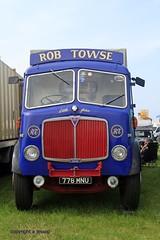History Of The Trucking Industry

- Find Out More About:
- Forklifts Hire Australia
History of the Trucking Industry
by
CWork
The trucking industry as we know it, began at the turn of the twentieth century with the invention of the motorized truck. Motorized vehicles were competition for the railroad industry and became a major factor in the increase of land transportation of goods throughout the United States. The development of fuel also contributed to the increased use of trucks. As motor technology advanced and improved, there was a natural progression for the construction of paved roads. As a result, there were regulations set by the state and federal government that were to be adhered to when moving freight.
Prior to the use of trucks, trains were the most efficient mode of transporting goods because it had the capacity to accommodate bulk. Trucks were initially used to deliver items to remote locations that were inaccessible for the train. The first boom in the usage of trucks occurred during the 1920s. At this time, roads were improving and made delivery locations more accessible. Eventually more durable tires replaced the rubber tires and trucks were made larger in order to carry more goods while providing comfort to the driver. The first trucks were extremely heavy and had crude mechanisms. Initially they were only providing delivery and hauling to the city. This restriction was due in large part because the trucks could not handle the pothole and unpaved roads. The Automobile Club of America put on the very first United States contest for commercial vehicles; the goal of the test was to examine the reliability, speed and capacity of the truck. Excited by the results of the contest, manufacturers were to meet the demand for trucks and the use of trucks for freight transportation flourished. The trucking industry as we know it was still in its infancy when the Great Depression hit and a number of trucking companies were forced to close their operations. The companies who survived were able to benefit from the repeal of Prohibition, which also occurred during a time of economic recovery. In 1935, Congress passed the Motor Carrier Act; this act halted the legislative mudslinging between the rail and automotive providers and provided structure for the industry. At that time, the federal government became an investor into the railroad industry, which happened to have also from the depression, as well as from the emerging auto transport industry. The Motor Carrier Act set regulations for freight-hauling. The act limited the hours that could be driven. It also mandated the classification of freight that could be carried. The owners of the trucking companies became concerned that the new regulations would compromise their competitive advantage over established rail companies. As infrastructures were improved, driver demand increased and opened up opportunity for new businesses to enter the market. The trucking industry is a key player in the American economy through the transportation of raw materials, produce, and finished goods. Trucks are also vital to the construction industry when large amounts of materials are needed for a project. Currently, the American trucking industry is responsible for most of the movement of freight and will continue to be essential for US manufacturing and construction. Under the regulation of ICC, companies who have for-hire trucks were required to apply for a license if they wanted like to enter the interstate markets. The guidelines were strict and licenses were granted only if it could be proven that there was a need for additional capacity. The rates, which used to be an agreement between the trucker and the customer, were put in the hands of bureaus. The rate bureaus are owned and administered by participating carriers. The bureaus job is to analyze costs and initiate pricing standards and competitive rates within the industry. In 1980, Congress put through a trucking deregulation bill. The goal of the bill was to increase competition and this competition resulted in reduced shipping costs for customers. Prior to 1983, truck size and weight limitations were set by individual states. The federal government pushed for legislation that set limitations on the interstate highway system. In addition to increasing the size and weight limitations on truck, the law also resulted in an increase of the national gas tax and increased fees on the industry. Currently, the trucking industry is responsible for paying roughly half of all state and federal road user taxes.
The highways and streets are filled with tractor trailer trucks moving goods from one place to another. The size and weight of the truck, and contact with a passenger vehicle can cause devastating accidents with deadly injuries. If you or a loved one has been injured in one of these serious accidents, contact a
Missouri 18-wheeler accident attorney
today.
Article Source:
History of the Trucking Industry